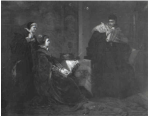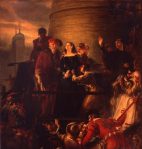In February of 1554, Lady Jane Grey wrote a farewell message to her father in the small prayer book she would carry with her to her execution.
The Lord comfort your Grace, and that in his word wherein all creatures only are to be comforted. And though it has pleased god to take away two of your children, yet think not, I most humbly beseech your Grace, that you have lost them, but trust that we, by leaving this mortal life, have won an immortal life. And I for my part, as I have honoured your Grace in this life, will pray for you in another life. Your Grace’s humble daughter, Jane Dudley.[1]
When reading this quote, one can only feel sympathy for the young girl who was about to lose her life, taking the time to comfort her father in the only way she knew how, by writing. Some of the words written within this short message do stand out, one sentence written by Jane has always interested me.
“we, by leaving this mortal life, have won an immortal life.”
When writing this, Jane is clearly discussing her beliefs that upon her death she will be welcomed into heaven due to her religious beliefs. Today, it is down to the individual to decide as to what opinion they feel regarding this. What is clear is that with her death, Jane most certainly did win that ‘immortal life’ discussed, especially within the world of art.
Almost immediately after Jane’s life was taken on that cold day in February 1554, two Jane’s began to appear. The first was the real Lady Jane Dudley, who was made queen, ruled for thirteen days, and was executed for high treason. The second was Lady Jane Grey, the innocent protestant martyr, who died for her religious beliefs and was bullied and manipulated by the people around her. One Jane would eventually overshadow the other as time progressed especially within depictions of her life.
February 2019 marked the 465th anniversary of the execution of Lady Jane Grey. It could be argued that today, with the use of the internet, social media, television, and film, her immortality is at its height. Her story has travelled down the centuries with the use of printed text and art and it continues to grab public interest today.
A large amount of paintings depicting various scenes from her life have been produced over the centuries. During the nineteenth and early twentieth century at total of 32 paintings depicting a scene from the life of Lady Jane Grey were exhibited in the Royal Academy of Art in London. Some have been inspired by real life events and others by fictional scenes from plays and books produced at various periods in time. Some paintings have also been inspired by the various portraits associated with Jane and in some cases, the artist has attempted to locate what was thought to be an authentic image of Jane and used this to create their own interpretation.
This part of the website will be used to create some sort of database to discuss the various paintings depicting scenes from the life of Lady Jane Grey produced after her death. These painting tell her life story, but they also reveal a great deal of the changing viewpoints in which Jane Grey was regarded in later times.
[1] Edwards. Stephan. The Lady Jane Grey’s Prayer Book, British Library Manuscript 2342, folio 78-80
Click on the individual images below to find out more.










https://www.tandfonline.com/doi/full/10.1080/23311983.2018.1533368
LikeLike
Thank you for posting this. I found Susan James article a while back and found it interesting. She does make some good points. The fact is, prior to being purchased by the NPG paint sampling was taken of the Lady Jayne inscription. It was found that the inscription was made at the same time as the portrait was painted and the actual paint used to create this is used elsewhere in the portrait. This then brings about the question as to why a portrait of Catherine Parr would be inscribed as Lady Jayne by the artist who created it if intact it was meant to be a painting of Parr? The Streatham portrait is a complex image unlike NPG4451 also re-Identified as Parr due to research produced by Susan James it has always been known as Lady Jayne. NPG4451 was called Catherine Parr for centuries prior to Roy Strongs re-identification as a portrait of Jane Grey in the 1960’s. It maybe possible that the Streatham portrait was based on a pattern used for Parr though, the Philip Mould portrait she uses in her article is not an exact match.
LikeLike
Check out S. James, ‘Lady Jane Grey or Queen Kateryn Parr?’ Burlington Magazine, cxxxviii, January 1996, pp.20-24 for multiple examples of Parr’s long portrait (NPG 4451) reproduced in prints as Jane Grey.
LikeLike
Yes, I have read that article. From memory, James discusses the Van da passe engraving published as Jane Grey in 1620. This is most definitely connected to NPG 4451. It was for many years thought to be Jane Grey due to a comment made in the book it featured in stating that ‘if an authentic image could not be located the the image of the individual would be left out’. This comment was taken as word for many centuries and the engraving was called Jane Grey until the new research on NPG 4451 in 1996. This engraving and a portrait similar known as the Hastings portrait was used by Roy Strong as the basis for the re-identification of NPG 4451 as Jane Grey in the 1960’s.
I have not come across any other engraving of a Parr portraits being called Jane. The Streatham portrait and royal collection engraving are connected though not to NPG 4451 which is a separate painting altogether.
The scientific investigation into the Streatham Portrait concluded that the portrait was meant to represent Lady Jayne at the time of its creation. The Royal collection engraving shows that this pattern appears to have been accepted as a likeness of Jane Grey prior to the creation of the Streatham portrait. The pattern may have been created to be used for the fashionable portrait sets of the 1580’s and 90’s and it is known that the artist workshops who created these sets would at times use a pattern of another individual to represent someone entirely different if an image, effigy or description could not be located.
I don’t think we will ever know for certain weather the portrait and engraving was based on a portrait of Parr until a painting that totally matches the Streatham Portrait shows up with Parr’s name on it.
LikeLike
https://tudorfaces.blogspot.com/2019/05/becoming-jane-streatham-portrait-of.html?m=1
This recent article by Roland Hui is also of interest when looking at the Streatham portrait and it’s connection to Jane Grey. If Hui’s theory is correct and the woodcut discussed dates to the 1580’s. This does show that a pattern similar to the Streatham portrait was being circulated as an image of Jane Grey prior to the creation of the portrait.
LikeLike